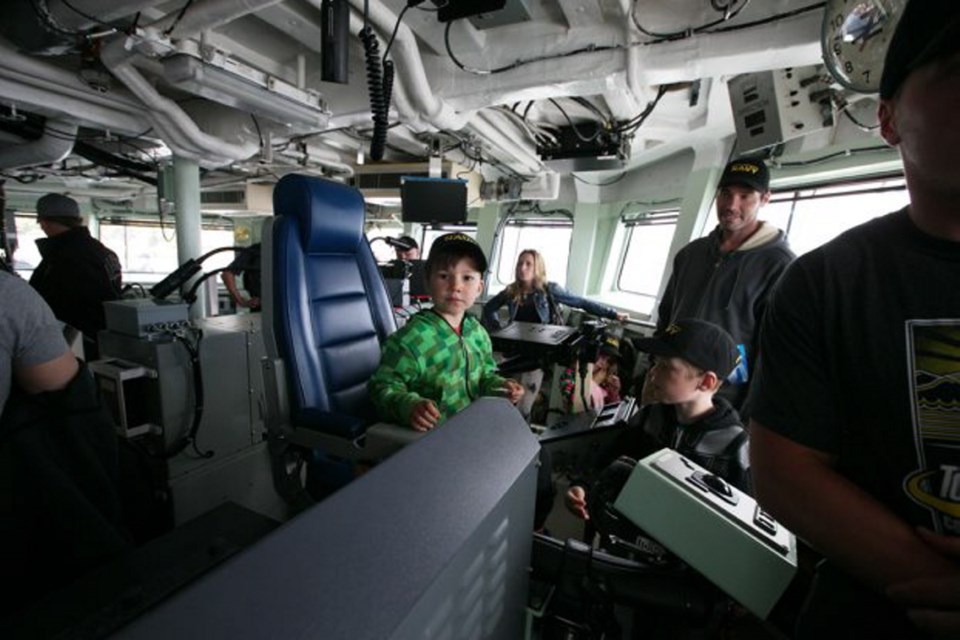When most of us turn onto Ocean Boulevard from the Old Island Highway, we’re usually en route to Fisgard Lighthouse, the sandy beaches of Cobourg Peninsula or the natural wonders of Esquimalt Lagoon.
Hundreds of visitors discovered a whole new world down there that’s usually off-limits upon their arrival at CFB Esquimalt, Colwood in complimentary shuttle buses for West Shore Navy Day on June 11.
“I didn’t even know this was here. I was gobsmacked,” said Scott Richardson, who attended out of curiosity with his son Alex Richardson, 18. “He’s interested in the naval reserves and wanted to have a look.”
Lt.-Cmdr. Desmond James said those are words the Royal Canadian Navy loves to hear, because it makes enlightening the public about what the navy does for Canadians that much more gratifying.
“There are so many things people don’t know about that, even on a day like today, there’s no way for them to see and understand everything we do,” the public affairs officer explained during a walkabout of the military base on Esquimalt Harbour. The base operations include Fleet Dive Unit (Pacific), the Colwood Refueling Facility and the Nuclear Biological and Chemical Warfare School.
Indeed, there was much to learn. When a leading seaman saluted as we approached a Maritime Tactical Operations Group display, I impulsively saluted him back before realizing what a dumb move that was.
“It’s about rank,” said James, explaining he was being saluted. Laughter ensued.
“We provide a capability the navy has never had before,” said Chief Petty Officer Brent Bethell, MTOG’s senior chief, explaining how the Albert Head-based enhanced naval boarding team enters hostile environments.
“We do higher-risk boardings that a standard ship’s boarding team can’t do. We reduce the risk a commanding officer has to assume.”
Highlights included tours of Grizzly, an Orca-class Patrol Craft Training Vessel, HMCS Winnipeg and HMCS Saskatoon, back from missions in the Mediterranean and anti-drug-smuggling ops in the Caribbean, respectively.
Visitors could also ride on grey rigid hull inflatable boats, use thermal-imaging cameras in a dark, smoke-filled military tent, watch mock search-and-rescue operations and a “tugboat ballet” by Glen-class tugboats that manoeuvre warships.
Children got the chance to learn knot-tying techniques using colourful licorice strings at a Sea Cadets information station.
“It’s a fun thing to do with cadets,” said Royal Canadian Sea Cadet Corps 263 Beacon Hill commander Lt. Cynthia Lawless. “Learning a new skill is one thing we try to teach all cadets.”
Some visitors were surprised to learn about CFB Esquimalt’s elaborate environment and safety division, noted environment officer Kara Foreman.
It ensures, among other things, that storage fuel tanks adhere to federal regulations, environmental policies and an emergency response plan is updated and that a solid-waste management plan is implemented.
“There’s a natural resources management program and we take care of species at risk, rare plants and wildlife,” she said. “We also have a camas species we monitor, as well as the deer and geese populations.”
Another fascinating display showcased projects made by apprentices within the Fleet Maintenance Facility Cape Breton Shop, including a 3-D representation of HMCS Algonquin Crest to honour its years of service.
“It’s mixing the old with the new,” said Aram Heinze, a third-year fitter-fabricator whose team combined traditional methods such as casting and blacksmithing with computer-assisted designs and water-jet cutting.
“It’s kind of a yin-yang dichotomy, a poetic thing we thought we’d play off — new apprentices, old journeymen,” said Heinze, whose creation includes a stunning serpent that represents the new age of submarines.
Other popular items included torpedoes of various shapes and sizes used on frigates, helicopters and marine patrol aircraft, and “dummy rounds” that resemble super-sized bullets.
There was no shortage of questions asked or military personnel to answer them and dispel misconceptions.
“What most people know about the military is what they’ve seen in movies, which we know isn’t necessarily real-life,” said James. “So this gives them an opportunity to see what we really do.”



